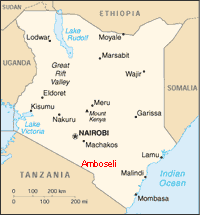Amboseli National Park lies between longitude 37°E and 37° 30' E and Latitude 2° 30' and 2° 45' S in southern Kenya, 240 km southeast of Nairobi. The southern boundary of the park lies less than 5 km from the Tanzanian border at the base of Africa's highest mountain, snow-capped Kilimanjaro. Amboseli is a small National Park, measuring only 392 km2. The park is managed by Kenya Wildlife Service - you can find their presentation about Amboseli here.
The name Amboseli comes from the Maasai place name, Empusel, meaning open plain. The Park itself is encompassed within a Pleistocene lake basin, formed when lava flows from an erupting Kilimanjaro blocked off the course of the Pangani River, creating a lake, which is now the Amboseli basin. Over the course of time the lake dried up although the basin is still prone to seasonal flooding. The flat topography of the basin is broken in only a few places by a number of small extinct volcanic vents known as Lemomo, Ositeti, Kitirua, Ilmberishari and Nomatior. To the south the land rises steadily toward Kilimanjaro, while to the North the park is clearly bounded by the shores of the Pleistocene lake.
Click on the map to the right to find a detailed Amboseli Elephant Research Project GIS-based poster showing Amboseli, including maasai bomas (homesteads) around the park in 2004. You'll find a higher quality version here (681kb). The continuing increase in the number of people and settlements in the Amboseli ecosystem is a serious threat to elephants and wildlife in general.

The area is classified as semi-arid savanna receiving between 200-400 mm of rainfall each year. Rainfall is concentrated in two rainy seasons, March-April and November-December. Melting snows and rainfall on Kilimanjaro percolate through the porous soil into an extensive subterranean aquifer reemerging in the basin as series of permanent swamps.
Two large swamps, Longinye and Enkongo Narok, transect the basin and numerous smaller swamps surface in the central and western parts of the park. The swamps are the life-blood of Amboseli and are home to a myriad of species of animals. Thus, the Amboseli basin and Amboseli National Park constitute a dry season concentration area for migrating species of the surrounding Amboseli ecosystem, an area of approximately 3,000 sq km.
Based on scientific assessment, the shrinking glaciers on Kilimanjaro could be gone by 2030 as a consequence of global warming. How this will affect the Amboseli ecosystem remains to be seen. Deforestation on the mountain slopes due to human activity is another major threat.

Amboseli Elephant Research Camp, Amboseli Trust for Elephants field base for the longest study of elephants in the world. The AERP was started by in 1972 by Cynthia Moss and Harvey Croze - Joyce joined in 1975. (©ElephantVoices)



